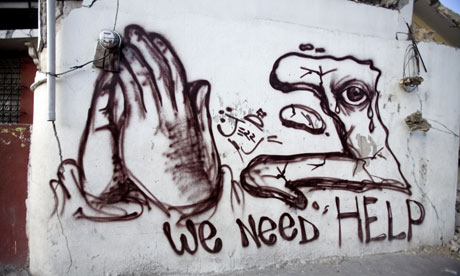
In the immediate aftermath of a disaster, from earthquakes to armed conflicts, survival depends on knowing the answers to questions such as: Is it safe to go back home? Should I stay where I am or go for help? Where are my family and friends? How and where can I go for help? Where is the nearest health facility?
For survivors of any disaster, huddled under tarps, among the rubble, on top of rooftops, or hidden in the bush, the concerns are not just for food, water or medicines. It is critically important that affected communities know how, when and where aid services can be accessed, what's going on around them, and how they can connect with aid providers. It's the start of restoring self-sufficiency, dignity and hope. The impact of this knowledge can be life-saving.
The need to know now
As Internews documented in the report "Connecting the last mile: the role of communications in the great east Japan earthquake," in a crisis, a community's need for information dramatically increases. People cannot wait for tomorrow. They need and want to know now – just as, US citizens needed and received information during Hurricane Sandy in October 2012.
However, in developing countries – think of Haiti after the quake, Indonesia post-tsunami or the Central African Republic during the current political upheaval – there is often a rapid decrease or even instantaneous halt to the amount and quality of information available for local people, those directly affected by the crisis. Dangerous rumours and misinformation begin to run rampant, causing panic and poor decision-making.
As we saw in Haiti, new technologies – primarily mobile, SMS, crisis-mapping and social media – increased the capacity for affected communities, diaspora groups and ordinary citizens to access, communicate and disseminate useful and actionable information, and also demand accountability.
The rapid growth of mobile, increased connectivity, crowdsourcing and mapping tools are accelerating access to vital information. After the earthquake in Japan, locally-driven initiatives such as Sinsai.info – a Japanese version of an Ushahidi Crisis Map – or Japan Google Person Finder became invaluable for both the local community but also the nation and the diaspora.
Humanitarian actors too, are finally adopting some of these tools more systematically within their work, relying on input from affected populations. Initiatives, such as the Digital Humanitarian Network (DHNetwork), are trying to create important inroads in the way aid organisations leverage technology and the power of volunteer tech communities.
Are we listening enough?
Yet to me, the question remains: are we listening enough? And, even more critically, what happens with those who fall through the cracks of the digital and age divide? What about those who live beyond that 'last mile' of existing communication infrastructure?
Despite important progress, particularly since the birth of the Communicating with Disaster Affected Communities (CDAC) network in 2009 and the infoasaid project (2010-2012), the humanitarian community has yet to fully realise that communication is one of the most powerful forms of aid. Humanitarian responses are still too often undermined because people's information needs are still considered a low priority.
And seeking for wider acknowledgement and use of ICT tools to provide information should not neglect the old medium on which people in developing countries most often rely – radio. The disaster in Haiti demonstrates, once again, that local radio is vital for survivors, and that combined with mobile technology and social media, it truly became a lifeline for audiences. In this hyper-connected world, and with over 5 billion mobile phones, the single piece of technology that has proved to work the best in emergency response is local radio.
Unfortunately, the potential of local media in emergency response is also vastly under-utilised and largely untapped by humanitarian organisations. "When the power goes down, community radio stations are essential lifelines, particularly in the early stages of a disaster. Sadly in normal times it is not acknowledged and funding is very limited," Masahiko Konno, technical director of Radio Ishinomaki, said.
Independent local media can improve humanitarian relief and enable people in the midst of crisis to take an active role in their own survival and recovery. Local media is commonly known and trusted by local people, speak the same language, are deeply familiar with local politics and culture, and are often also victims of the disaster. Yes, local journalists also need to fend for themselves and their families, but they can also cover, and do cover, that 'last mile', that one where no mobile phone, internet connection or big data algorithms can reach.
If recent disasters confirm one thing it is that information saves lives, that communication itself is a form of aid, and that failing to effectively engage local communities not only disengages them from the aid response, it also undermines the effectiveness and accountability of humanitarian operations. When the next humanitarian disaster hits, that radio tower on a hill isn't just a broadcast. It's a lifeline.
Wednesday 3 April 2013
http://www.guardian.co.uk/global-development-professionals-network/2013/apr/03/disaster-communications-ict-internews

0 comments:
Post a Comment